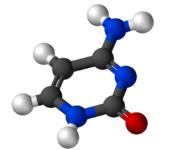Cytosine
 |
|
 |
|
 |
|
| Names | |
|---|---|
|
IUPAC name
4-aminopyrimidin-2(1H)-one
|
|
| Other names
4-amino-1H-pyrimidine-2-one
|
|
| Identifiers | |
|
71-30-7 |
|
| 3D model (Jmol) | Interactive image |
| ChEBI |
CHEBI:16040 |
| ChEMBL |
ChEMBL15913 |
| ChemSpider |
577 |
| ECHA InfoCard | 100.000.681 |
| KEGG |
C00380 |
| MeSH | Cytosine |
| PubChem | 597 |
| UNII |
8J337D1HZY |
|
|
|
|
| Properties | |
| C4H5N3O | |
| Molar mass | 111.10 g/mol |
| Density | 1.55 g/cm3 (calculated) |
| Melting point | 320 to 325 °C (608 to 617 °F; 593 to 598 K) (decomposes) |
| Acidity (pKa) | 4.45 (secondary), 12.2 (primary) |
| -55.8·10−6 cm3/mol | |
|
Except where otherwise noted, data are given for materials in their standard state (at 25 °C [77 °F], 100 kPa).
|
|
|
|
|
| Infobox references | |
Cytosine (/ˈsaɪtəˌsiːn, -ˌziːn, -ˌsɪn/;C) is one of the four main bases found in DNA and RNA, along with adenine, guanine, and thymine (uracil in RNA). It is a pyrimidine derivative, with a heterocyclic aromatic ring and two substituents attached (an amine group at position 4 and a keto group at position 2). The nucleoside of cytosine is cytidine. In Watson-Crick base pairing, it forms three hydrogen bonds with guanine.
Cytosine was discovered and named by Albrecht Kossel and Albert Neumann in 1894 when it was hydrolyzed from calf thymus tissues. A structure was proposed in 1903, and was synthesized (and thus confirmed) in the laboratory in the same year.
In 1997 cytosine was used in an early demonstration quantum information processing when Oxford University researchers implemented the Deutsch-Jozsa algorithm on a two qubit nuclear magnetic resonance quantum computer (NMRQC).
...
Wikipedia
